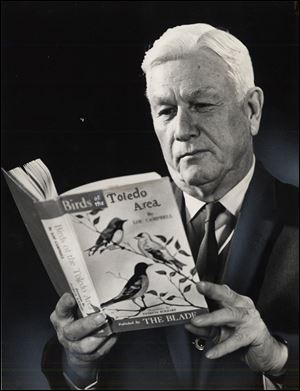
Campbell's research makes us richer birders
5/11/2012
Lou Campbell peruses a copy of his 1968 book, 'Birds of the Toledo Area.' He began researching and documenting the bird population in the Toledo area in 1926, and in 1940 he crafted a comprehensive guide called 'The Birds of Lucas County,' which was published by the Toledo Zoological Society. The 1968 updated and revised text was published by The Blade.
OAK HARBOR, Ohio -- The congregation of birders that has wedged into the parking lots and worn out the boardwalks at the state and federal marshes along the lake this spring are all disciples of Lou Campbell.
Some of them just don't know it.
They might not be aware that the late author and naturalist is the de facto patron saint of birding in this region.
While bird watching and bird photography in Northwest Ohio is not a recent phenomenon, since major flyways have funneled migratory birds through the wetlands of Ottawa and Lucas counties for millennia, Campbell's work to scientifically document the annual event gave it a written history. He was the pioneer.
Campbell began researching and documenting the bird population in the Toledo area in 1926, and in 1940 he crafted a comprehensive guide called The Birds of Lucas County, which was published by the Toledo Zoological Society. In 1968, his updated and revised text called Birds of the Toledo Area was published by The Blade.
"As a kid who grew up with his book as my birding bible, you could always find the answer in Lou Campbell's works," said Matt Anderson, who is recognized as a local birding expert. "If I had a question about what I was seeing, and if it was unusual or not, that book had the information I needed."
READ MORE from Matt at the Blade Outdoors blog
Campbell, a native of Toledo who worked as a traffic engineer for Community Traction Co., the predecessor to TARTA, also wrote an outdoors column for The Toledo Times for 33 years. His birding books, studies of the wetlands around the then-proposed Davis-Besse Nuclear Power Station, his early writings on the Oak Openings region, and his passionate campaign against the aerial spraying of such persistent pesticides collectively made Campbell an icon in the distinct fraternity of conservationists and serious birders.
"His first book represented a breakthrough. It was very well respected, and recognized as one of the most detailed and accurate books of its kind," said Kenn Kaufman, an author and naturalist known for his popular field guides on North American birds and butterflies.
"Campbell wasn't professionally trained in ornithology, but he got seriously interested in birds and rapidly became an expert in the field. He was very careful about his records and those of others that were submitted to him. He sifted through things many times, and he established a long-term tradition of accuracy and very precise work."
Anderson, who on Wednesday led a birding tour at Oak Openings Preserve as part of the ongoing "Biggest Week in American Birding" event, remembers the anxious moments he experienced many years ago, waiting to find out if his field work would be deemed suitable by Campbell.
"I picked up birding from my dad when I was in about the sixth grade. My dad knew Lou Campbell, and I knew how important he was in the field," Anderson said. "You never thought you'd made it as a legitimate birder until Lou Campbell accepted your records. He was a skeptic, first and foremost, and that's one of the reasons he was so good at what he did."
Campbell also wrote more than 45 articles for prestigious scientific publications, such as those of the American Ornithologists' Union and Wilson's Ornithological Society. Anderson said the depth, breadth, and detail in Campbell's work is astounding.
"Keep in mind that he gathered all of that information in a day and age when it was not that easy to get around these areas, or to record and store the data you collected," Anderson said.
"His books are the landmark texts for anyone in this area who grew up when I did and was interested in the birds we see here. We have very special places and opportunities here that are attracting huge crowds today, but Lou Campbell recognized those things more than 75 years ago."
Anderson was part of a collaborative update of Campbell's book about 10 years ago.
"We were five serious local birders who had Lou Campbell's book at our fingertips all of the time, and it took us six or seven years of work to update it," he said. "One thing is for certain -- we developed a new appreciation for the monumental amount of work he did from scratch."
Campbell, who started his career as an outdoors writer in 1930 at the former Toledo News-Bee, continued to write for The Blade following his retirement from what was by then TARTA, at the age of 70. He died in 1998, at age 98. His name graces the 210-acre Lou Campbell State Nature Preserve east of Toledo Express Airport, where rare plants, butterflies, and summer wildflowers find a home.
"For a lot serious birders, an older bird book like his has considerable value as we try to understand what's going on here," Kaufman said. "I find myself constantly going back and looking at Lou Campbell's book -- the original and the update. It is a very valuable resource to look at how things were."
Anderson said despite the more than 70 years that have passed since Campbell's first book was published, Campbell remains royalty in the birding ranks.
"He was the king, and he still is," Anderson said. "When you get right down to it, there was nobody that could touch him."
Contact Blade outdoors editor Matt Markey at: mmarkey@theblade.com or 419-724-6068.